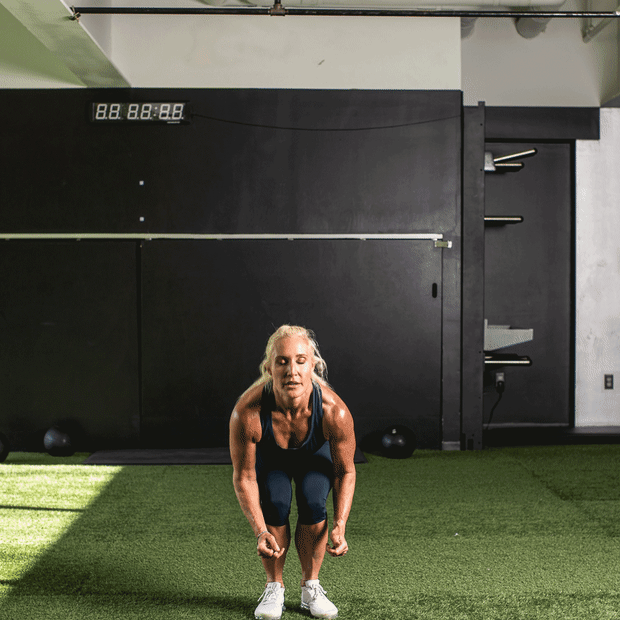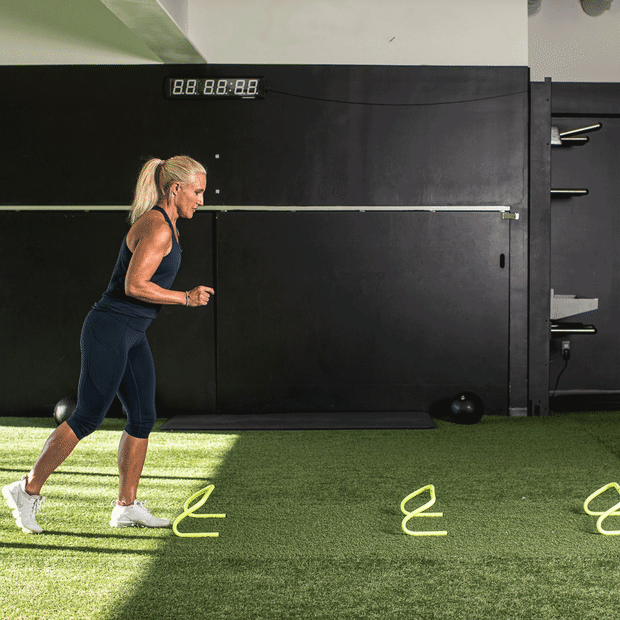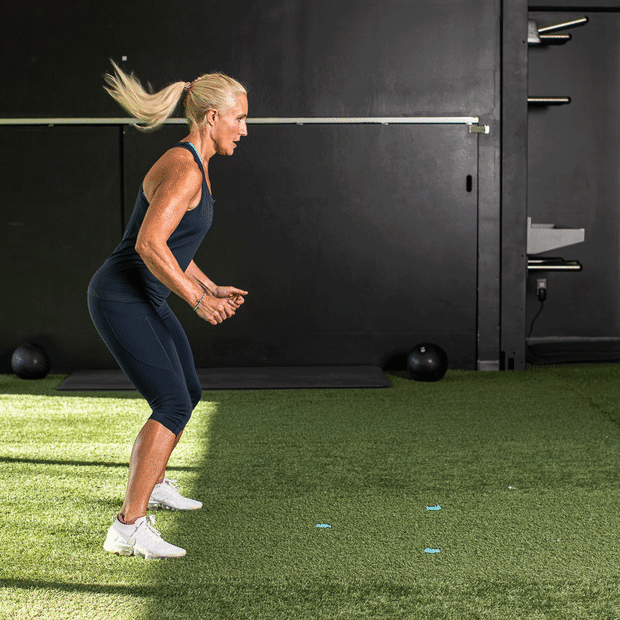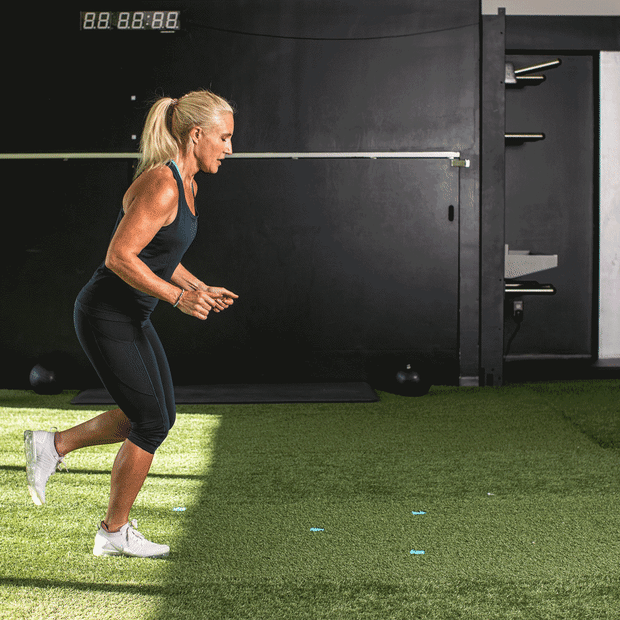Five Exercises to Boost Speed and Agility
Lacrosse is a physically intense sport that requires players to use netted sticks to scoop up, carry and shoot a ball into a goal, all while evading opponents.
The sport requires speed, agility and coordination, says Dr. Karen M. Sutton, the Stamford, Conn.-based chief medical officer for World Lacrosse and a sports-medicine surgeon at the Hospital for Special Surgery. “You also need dexterity and stamina, as well as the ability to dodge quickly.”
Being able to think on your feet and change directions quickly is crucial on the field, says Dr. Sutton, a 45-year-old former Duke University lacrosse player. These skills also help you avoid injuries in day-to-day life.
As we age, we tend to slow down. Training for speed and agility can come in handy whether you want to improve your 5K time or avoid injury the next time you need to sprint to catch the subway. We also tend to move in a forward plane of motion. Working other planes in dynamic ways can help train the body for when you need to suddenly lunge to catch a Frisbee while playing with your kids, or swerve your shopping cart.
The following five drills will help increase your stamina and dexterity, with a focus on quick movements and coordination. Start slow and focus on control, Dr. Sutton says. Once you have full control of a movement, build speed.
The Workout
Star Jumps
Why: This plyometric exercise is a great way to build strength and stamina, especially in your legs. “Think of them as an upgraded jumping jack,” says Dr. Sutton.
How: Start in a squatting position with your feet together and arms by your sides. Bear down through your feet and as you jump off the ground, extend your arms and legs into an ‘X’ position. Land as gently as you can with your feet together and lower yourself back into a squat position. Increase the height of your jump as you get more comfortable. Repeat 10 to 12 times.
Option: If this move is too difficult, reduce the height of the jump or eliminate it all together. Keep one leg on the ground and extend your opposite leg and arms into an ‘X’ position. As this becomes easier, add a small hop into the mix.

Dr. Sutton demonstrates how to do star jumps.
Shuttle Runs With Burpees
Why: Shuttle runs require you to sprint to a marker, touch it, sprint back to the start and repeat. Burpees combine a squat and high plank pose. Both are high-intensity exercises that build stamina and coordination. “They aren’t easy, but they will directly benefit your ability to change positions quickly,” says Dr. Sutton.
How: Set two markers on the ground. One will be your starting point. You should stand facing the other. Run toward the second marker, but slow down just before you reach it.
At the marker, with your feet shoulder-width apart, lower into a squat and place your hands on the ground. While breathing in, jump your feet behind you into a plank pose. You should be on the balls of your feet with your body in a straight line. Breathe out, and jump your feet forward, between your hands. Straighten back into a standing position, then turn and run toward the first marker. Repeat the burpee at the first marker, and continue for 10 sets.
Options: Increase the number of burpees with each sprint or add a push up to the burpee for an added challenge.
Mini Hurdles
Why: “Mini hurdle drills are excellent for acceleration and speed training, as well as working on your stride,” says Dr. Sutton. You can buy small hurdles or use anything you have around the house that’s about 6 inches tall, or small enough that you can comfortably jump over, such as a shoebox or a mini garbage can, she says.
How: Set up 10 hurdles about 3 feet apart. Run quickly between the hurdles, jumping lightly over each one, leading with your right foot for one direction, then leading with the left foot on the return. The goal is to keep your jumps light and focus on never making contact with the hurdles. Repeat 10 times.
Options: Jump with both feet together or do this drill laterally by side stepping or hopping sideways over the hurdles.

Dr. Sutton says hurdle drills help improve acceleration and speed.
Ickey Shuffle
Why: The Ickey Shuffle was named for a touchdown celebration dance performed by former Cincinnati Bengals player Elbert “Ickey” Woods. Former Bengals quarterback Boomer Esiason has described it as “a cross between the Hokey Pokey, the Macarena and the Humpty Dance.” While it might look funny, Dr. Sutton notes it’s great for training dexterity and coordination. “Think of it as an athletic take on hopscotch,” she says.
How: Place a ladder across the floor, or use tape or rolled up towels to create a ladder. Start at one end of the ladder and step into the first square on the toes of your right foot. Bring your left foot into the square, also on your toes, while moving your right foot outside the square to the right.
Now move your right foot into the next square while simultaneously moving your left foot outside the first square to the left. Both feet should never be inside or outside the ladder at the same time. Start slowly and focus on control. Gradually increase your speed. It helps to recite a three-step count in your head: “In, out, up,” says Dr. Sutton.

Dr. Sutton does the Ickey Shuffle, a drill inspired by a touchdown dance performed by a former Cincinnati Bengals player.
Five Dot Drill
Why: The Five Dot Drill protocol is an effective exercise to improve agility, mirroring movement used frequently by lacrosse players. It will also help the nonathlete move more fluidly and safely as they lunge to grab a falling object or perform other sudden movements which can often result in pulled muscles or other injuries.
How: Use chalk or tape to create a two-foot-by-three-foot rectangle. Place heavy duty tape as a marker in each corner of the rectangle and one in the center. You can also draw markers on pavement with sidewalk chalk. The corners closest to you are A and B, the marker in the center is C, and the corners furthest away are D and E. Perform six reps of each of the five exercises without rest and try to move as quickly as possible.
Exercise 1: Up and Back
1. Start with feet on A and B.
2. Jump rapidly with both feet onto C.
3. Jump putting one foot on D and one on E.
4. Jump to the start in reverse and repeat.

Dr. Sutton performs the first variation of the five dot drill, moving up and back.
Exercise 2: Right Foot
1. Your feet are now on A and B.
2. Jump on C with your right foot.
3. Jump with your right foot on D, E, C, A, B.

Dr. Sutton does variation two of the five dot drill, leading with her right foot.
Exercise 3: Left Foot
1. The previous exercise ends with your right foot on B.
2. Jump with your left foot on C.
3. Jump with your left foot on D, E, C, A, B.
Exercise 4: Both Feet
1. The previous exercise ends with your left foot on B.
2. Jump with both feet on C.
3. Jump with both feet on D, E, C, A, B.
4. Jump back to the starting point.
Exercise 5: Turn Around
1. The previous exercise ends with both feet on B.
2. Jump with both feet on C.
3. Jump putting one foot on D and one on E, just like in exercise number one.
4. Turn around clockwise 180 degrees. Your feet will still be on D and E.
5. Jump on C with both feet and then with one on A and one on B
6. Turn again around to the left, counterclockwise 180 degrees and start again.
Write to Jen Murphy at [email protected]
Copyright ©2020 Dow Jones & Company, Inc. All Rights Reserved. 87990cbe856818d5eddac44c7b1cdeb8
For all the latest Life Style News Click Here
For the latest news and updates, follow us on Google News.
